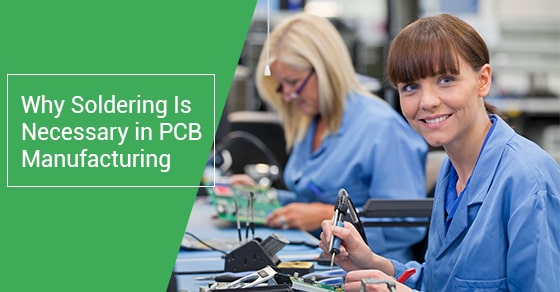Why Soldering Is Necessary in PCB Manufacturing
The printed circuit board (PCB) assembly process is complex. Soldering serves as the first step in the PCB assembly process. A botched soldering job may cause the device in question to not work as designed. For example, it may malfunction, which could lead to lost time and money.
Given the importance of soldering, we will outline its necessity below. We will also discuss circuit board design in Waterloo and how it relates to PCB manufacturing.
The Fundamentals of PCB Soldering
Electrical components can be affixed to PCBs using a variety of soldering techniques. A pick-and-place apparatus may be used in order to lift components and set them on the board. Automated devices are often used when printed circuit boards are mass-produced. As for the joints, they are reinforced by using reflow ovens that heat the solder before allowing it to gradually cool over time.
In regards to low-volume jobs, such as when working with prototypes, a skilled technician will solder the component manually. A solder alloy and a soldering iron are often used by technicians in order to build prototypes.
In some cases, the components that are used may be very tiny. In such a scenario, the technician will use a handy pair of tweezers and a leading-edge microscope in order to precisely guide the components.
Soldering has been used for thousands of years. In fact, there is evidence of metal-work soldering having been completed during the Mesopotamia era. Today, every smart device that is manufactured requires a printed circuit board in order to work. Some of the components used are smaller than a grain of rice, which may cause alignment issues if the soldering team is not careful.
Surface-Mount vs. Through-Hole Components
Through-hole components have wired legs. The legs are fit through tiny drill holes. As for surface-mounted units, they are placed at the apex of the board.
The majority of PCB companies will use surface-mounted components, as they are easier for automated devices to handle.
How to Solder Surface-Mount Components
First, you must apply solder paste. A state-of-the-art solder paste stencil device should be used in order to precisely release trace amounts of the paste. The amount released should be sufficient to adhere the small components onto the board.
Solder paste stencil machines are often used for mass production projects. Next, the components and board are passed through a cutting-edge reflow oven via a conveyor belt. The temperature of the board will slowly rise until the paste begins to melt. The board is subsequently cooled so that the material will harden. The end result is a stable joint between the component and the material, adhering it to the PCB.
If you are concerned about the amount of paste being applied, then you should use a solder paste inspection device. The machine will ensure that the right amount is applied, as too much or too little paste may lead to malfunction and/or defects.
Automated Optical Inspection
Once the board is removed from the oven, the soldering process will end. The majority of printed circuit board factories will use automated optical inspection (AOI) machines in order to inspect every board. The newly assembled PCBs are compared to a master board in order to determine if there are any mismatches.
Faulty boards, if applicable, will be fixed by skilled technicians using a top-of-the-line soldering iron. The AOI machine will also ensure that the solder joints are sound. While manual testing can be used, AOI machines are far more effective, and much quicker as well.
Automated vs. Manual
Configuration costs and machine setups are considered far too time-consuming and expensive for low-volume runs. Manual soldering and hand assembly are considered the norm for low-production runs and prototype builds.
Intricate work that is being performed in small areas should also be left to a technician. Such projects may prove to be too difficult to solder using an automated device. In sum, manual soldering is commonly used for most through-hole components when the volume being produced is small.
Wave Soldering Machines
Wave soldering machines are often used when many through-hole components are involved. They are also commonly used for high-production volume projects.
Wave soldering uses a liquid solder pool in order to adhere metal components on the base of the board (e.g., wire legs of through-hole units, copper pads). A green solder mask is commonly used in order to prevent the liquid solder from adhering to other components.
Wave soldering is faster than many other conventional methods. It is also far more effective than manual soldering for most projects, and can be used for both through-hole and surface-mounted components.
Quality Control
The soldering process is not perfect. Quality control tests are often conducted throughout the entire procedure. The work does not end after soldering either. Technicians must carefully test the component’s functionality after the soldering process has ended. Most modern soldering and PCB assembly factories use leading-edge IoT (Internet of things) machines in order to perform examinations using test scripts.
The most advanced factories will also use powerful X-ray machines in order to screen every board that is assembled. In sum, PCB assembly and soldering are very complicated and delicate processes. They should not be left to an amateur or semi-skilled worker.
The Circuits Central Difference
If you would like to learn more about circuit board design or require circuit board design, then please visit our website. Circuits Central specializes in PCB prototyping and quick-turn assembly.
In fact, we provide prototype assembly in 24 hours or even less in some cases. We also offer first-article inspection, obsolescence planning, and design for manufacturing feedback. We can be reached at 1-888-821-7746 for a free, no obligation quote and consultation if you would prefer to discuss your PCB assembly and soldering needs over the phone.

